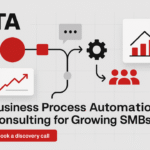
Wilton Rogers
June 16, 2025
The Smart Way to Automate Without Wrecking What Already Works
Every growing team eventually hits the same wall:
“We’re spending too much time on repetitive tasks, but we can’t risk breaking our current systems.”
Sound familiar?
Whether you’re in real estate, retail, accounting, manufacturing, or client services—the fear is real: automate the wrong way, and you’ll create more mess than magic.
Here’s the good news:
You don’t need to overhaul everything. You just need to automate with intention.
Let’s walk through how to reduce manual tasks without breaking what already works.
Before you even think about software, pause.
Ask yourself:
What tasks are eating up the most time?
Where do handoffs break down?
What’s being done manually that could be done better?
Map your workflows first. This can be as simple as drawing boxes and arrows. The goal is to see your current system clearly—so you can automate the right parts, not the wrong ones.
🧠 Pro Tip:
Use sticky notes, whiteboards, or tools like Lucidchart, Whimsical, or even Google Docs. Visibility creates clarity.

Don’t automate everything at once. Choose one high-impact, low-risk task—something small, annoying, and repeatable.
Examples across industries:
Real Estate: Automate rent reminders or showing confirmations
E-commerce: Auto-send order status updates or follow-ups
Accounting: Use forms that auto-feed into QuickBooks
Customer Service: Route common inquiries with a chatbot
Manufacturing: Auto-generate inventory alerts or shift schedules
Start here. Test. Measure. Build confidence.

One of the biggest mistakes? Adding new tools that don’t play well with your existing stack.
Instead, look for systems that:
Connect to your CRM, calendar, email, or spreadsheets
Don’t require a full migration
Let you build automation in layers, not leaps
Popular tools that work with you:
Zapier (for no-code automation between apps)
Make (Integromat) (for complex workflows)
ChatGPT/AI agents (for emails, reports, and triage)
CRMs like GoHighLevel, HubSpot, or Zoho (that have built-in automation)

Automation is not about replacing people or distancing yourself from the process—it’s about giving your team more bandwidth to do what humans do best.
Let the bots handle:
Data entry
Scheduling
Notifications
Routine follow-ups
Let your team focus on:
Strategy
Relationships
Decisions
Creative problem-solving
Automation done right brings clarity, not confusion.

Here’s a simple rollout plan:
Automate one task
Observe the results
Ask: did this save time, reduce errors, or improve flow?
Refine and document the process
Train your team before scaling to more areas
Automation isn’t “set it and forget it”—it’s “test it, tweak it, then trust it.”
You don’t need to be tech-savvy to reduce manual tasks.
You just need to be process-smart and willing to start small.
Your systems don’t have to break to improve.
They just need room to grow—with automation as your ally.
Let us show you exactly where to start.
👉 Schedule a Free Automation Assessment



© 2024 ScaleThroguhAutomation, All right reserved.